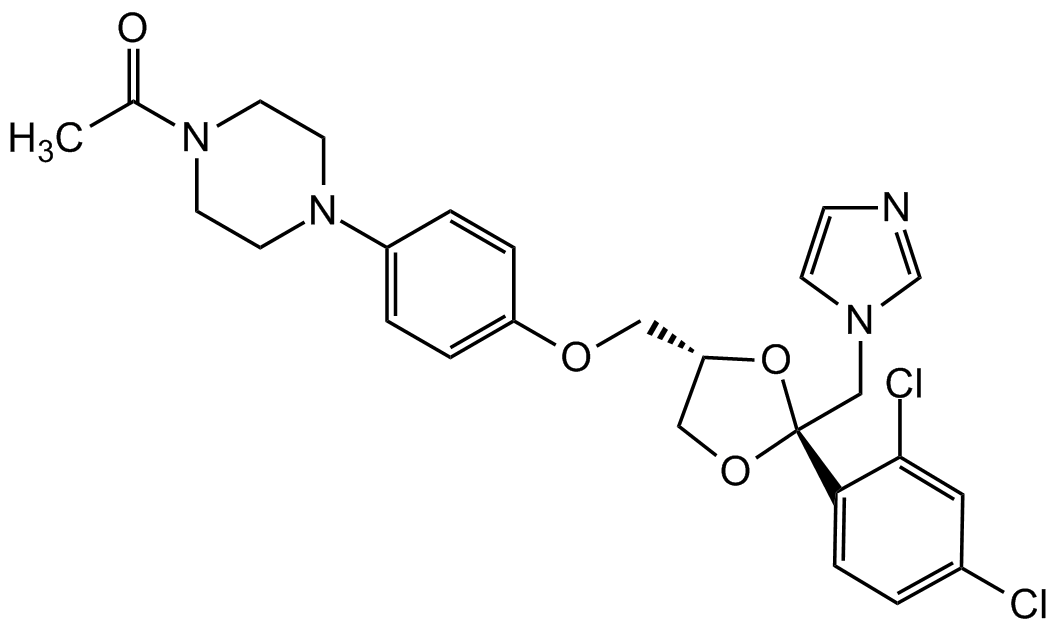Ketoconazole
| Code | Size | Price |
|---|
| CDX-K0016-G001 | 1 g | £84.00 |
Quantity:
| CDX-K0016-G005 | 5 g | £316.00 |
Quantity:
Prices exclude any Taxes / VAT
Overview
Regulatory Status: RUO
Shipping:
AMBIENT
Storage:
Short Term: +4°C, Long Term: -20°C
Images
Documents
Further Information
Alternate Names/Synonyms:
(?)-cis-1-Acetyl-4-(4-[(2-[2,4-dichlorophenyl]-2-[1H-imidazol-1-ylmethyl]-1,3-dioxolan-4-yl)-methoxy]phenyl)piperazine; R 41400; NSC 317629; BRN 4303081
Appearance:
White to off-white powder.
CAS:
65277-42-1
Class:
6.1
EClass:
32160000
Form (Short):
liquid
GHS Symbol:
GHS06,GHS08,GHS09
Handling Advice:
Protect from light and moisture.
Hazards:
H361
InChi:
InChI=1S/C26H28Cl2N4O4/c1-19(33)31-10-12-32(13-11-31)21-3-5-22(6-4-21)34-15-23-16-35-26(36-23,17-30-9-8-29-18-30)24-7-2-20(27)14-25(24)28/h2-9,14,18,23H,10-13,15-17H2,1H3/t23-,26-/m0/s1
InChiKey:
XMAYWYJOQHXEEK-OZXSUGGESA-N
Long Description:
Chemical. CAS: 65277-42-1. Formula: C26H28Cl2N4O4. MW: 531.43. Ketoconazole is a broad-spectrum triazole antifungal agent that has activity against C. albicans, C. krusei, C. tropicalis, C. glabrata, C. parapsilosis, C. neoformans and A. fumigatus strains (IC50s = 0.031-8 µg/ml). It inhibits the fungal cytochrome P450 (CYP) isoform CYP51, also known as lanosterol 14alpha-demethylase, which arrests ergosterol biosynthesis at the fungal membrane. This interaction inhibits ergosterol synthesis and results in increased fungal cellular permeability. Ketoconazole also inhibits human CYP3A4 (IC50 = 0.54 µM). Formulations containing ketoconazole have been used in the treatment of fungal infections. Ketoconazole blocks in humans activity of several enzymes necessary for the conversion of cholesterol to steroid hormones such as testosterone and cortisol. It has been shown to inhibit cholesterol side-chain cleavage enzyme, which converts cholesterol to pregnenolone, 17alpha-hydroxylase and 17,20-lyase, which convert pregnenolone into androgens, and 11beta-hydoxylase, which converts 11-deoxycortisol to cortisol. All of these enzymes are mitochondrial cytochrome p450 enzymes. Based on these antiandrogen and antiglucocorticoid effects, ketoconazole has been used with some success as a second-line treatment for certain forms of advanced prostate cancer and for the suppression of glucocorticoid synthesis in the treatment of Cushing's syndrome. Ketoconazole displays potent anti-metastatic, anti-neoplastic, and anti-psoriatic activities and acts as an inhibitor of 5-lipoxygenase (5-LO) and thromboxane synthase activities.
MDL:
MFCD00058579
Molecular Formula:
C26H28Cl2N4O4
Molecular Weight:
531.43
Package Type:
Vial
PG:
III
Precautions:
P201-P273-P301 + P310-P308 + P313-P501
Product Description:
Ketoconazole is a broad-spectrum triazole antifungal agent that has activity against C. albicans, C. krusei, C. tropicalis, C. glabrata, C. parapsilosis, C. neoformans and A. fumigatus strains (IC50s = 0.031-8 µg/ml). It inhibits the fungal cytochrome P450 (CYP) isoform CYP51, also known as lanosterol 14alpha-demethylase, which arrests ergosterol biosynthesis at the fungal membrane. This interaction inhibits ergosterol synthesis and results in increased fungal cellular permeability. Ketoconazole also inhibits human CYP3A4 (IC50 = 0.54 µM). Formulations containing ketoconazole have been used in the treatment of fungal infections. Ketoconazole blocks in humans activity of several enzymes necessary for the conversion of cholesterol to steroid hormones such as testosterone and cortisol. It has been shown to inhibit cholesterol side-chain cleavage enzyme, which converts cholesterol to pregnenolone, 17alpha-hydroxylase and 17,20-lyase, which convert pregnenolone into androgens, and 11beta-hydoxylase, which converts 11-deoxycortisol to cortisol. All of these enzymes are mitochondrial cytochrome p450 enzymes. Based on these antiandrogen and antiglucocorticoid effects, ketoconazole has been used with some success as a second-line treatment for certain forms of advanced prostate cancer and for the suppression of glucocorticoid synthesis in the treatment of Cushing's syndrome. Ketoconazole displays potent anti-metastatic, anti-neoplastic, and anti-psoriatic activities and acts as an inhibitor of 5-lipoxygenase (5-LO) and thromboxane synthase activities.
Purity:
99.0-101.0% (EP, Titration)
Signal word:
Danger
SMILES:
CC(N(CC1)CCN1C2=CC=C(OC[C@H]3CO[C@](CN4C=NC=C4)(C5=CC=C(Cl)C=C5Cl)O3)C=C2)=O
Solubility Chemicals:
Soluble in DMSO (30mg/ml) or ethanol (20mg/ml) or methanol (20mg/ml).
Transportation:
Excepted Quantity
UN Nummer:
2811
UNSPSC Category:
Biochemical Reagents
UNSPSC Number:
12352200
Use & Stability:
Stable for at least 2 years after receipt when stored at -20°C.
References
(1) D.S. Loose, et al.; J. Clin. Invest. 71, 1495 (1983) | (2) D.S. Loose, et al.; J. Clin. Invest. 72, 404 (1983) | (3) M. Borgers, et al.; Am. J. Med. 74, 2 (1983) (Review) | (4) J.H. Van Tyle; Pharmacotherapy 4, 343 (1984) (Review) | (5) M. Ayub & M.J. Levell; J. Steroid Biochem. 32, 515 (1989) | (6) C. Eil; Horm. Metab. Res. 24, 367 (1992) | (7) R. Dumaine, et al.; J. Pharmacol. Exp. Ther. 286, 727 (1998) | (8) A. DeVries, et al.; Pharmacotherapy 18, 581 (1998) (Review) | (9) S. Dilmaghanian, et al.; Chirality 16, 79 (2004) | (10) D.J. Greenblatt, et al.; Xenobiotica 40, 713 (2010) (Review) | (11) V. Patel, et al.; Nat. Rev. Urol. 15, 643 (2018) (Review)



